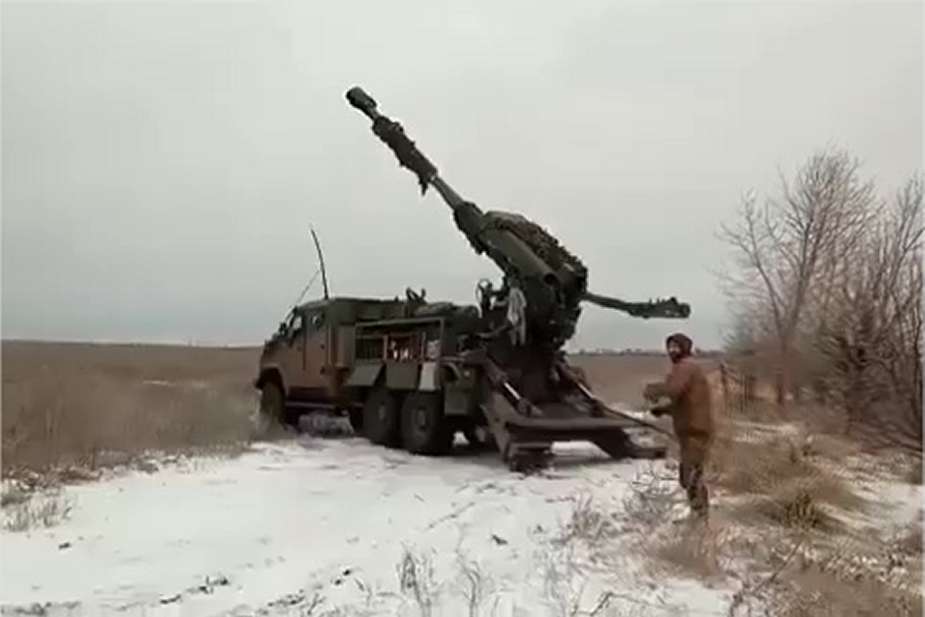As demonstrated by the deployment of the upgraded Bohdana 2.0, a 155mm self-propelled howitzer equipped with a redesigned cabin of Varta APC, by the 57th separate motorized infantry brigade, Ukraine's recent advancements in military capabilities, particularly in artillery, are evident. This is part of Ukraine’s initiative to update and strengthen its artillery in response to the decrease in the delivery of artillery systems to Ukraine from European allies and the United States.
Follow Army Recognition on Google News at this link

The Bohdana 2.0 155mm self-propelled howitzer, based on a 6x6 MAZ-6317 truck chassis, can be deployed in 1.5 minutes. (Picture source: Twitter/counter_tracker)
President Volodymyr Zelenski recently commented on the decrease in the delivery of artillery shells and systems to Ukraine from Western allies. This decrease has been observed since the beginning of the Israel-Hamas conflict. Zelenski particularly noted a slowdown in the supplies of 155mm artillery shells. He also mentioned that the United States had not formally stated that they would stop or decrease the flow of artillery shells to Ukraine, but rather that there was a general scramble for stockpiles by everyone involved. Zelenski acknowledged this situation as a reality they must deal with, emphasizing the need for Ukraine to defend what's theirs despite these challenges, including the potential end of US military aid.
The current emphasis on domestic production of artillery systems and ammunition has therefore become an essential aspect of Ukraine's defence strategy. Faced with the current conflict between Israel and Hamas, and the need to lessen dependence on foreign supplies, Ukraine has been concentrating on developing its artillery capabilities. This includes creating new systems and maintaining existing ones, with support from international partners.
One of Ukraine's significant achievements in locally-made artillery development is the new Bohdana 2.0 155mm self-propelled artillery system. It combines firepower with mobility and is equipped with a 155 mm/52 caliber gun system, designed for long-range engagements and rapid deployment. This shift reflects Ukraine's move from Soviet-era ammunition calibers (122mm and 152mm) to NATO-standard 155mm calibers, influenced in part by the supply of similar caliber artillery systems from Western nations, but also the need for a modern self-propelled howitzer produced locally.
The Bohdana has a firing rate of 5 rounds per minute, can be deployed in 1.5 minutes, and has a capacity of 20 rounds. Despite a combat weight of up to 28 tons, it has a mobility of up to 80 km/h on roads and 30 km/h off-road, with a range of up to 800 km on-road and 500 km off-road. Multiple chassis options are available to rapidly augment the artillery capabilities of the Ukrainian armed forces, as reported by Army Recognition on December 12, 2023, including KrAZ for the Bohdana 1.0, MAZ for the Bohdana 2.0, and Tatra for the Bohdana 3.0.
Ukraine's defense industry has also progressed in the production of artillery ammunition, with about 20% of shells currently used being domestically produced, and up to 50% for certain types of ammunition. The production scope includes mortars, towed artillery, unmanned systems, and missile systems, with ongoing development and testing of an increased number of various types of weaponry, alongside strengthening the actual industrial base.
Following the USSR's collapse, Ukraine had substantial reserves of 152 mm Soviet-caliber artillery ammunition, but these have been depleted due to the conflict since 2014 and Russian activities. Consequently, there has been a focus on increasing domestic production, distributed across multiple cities to reduce the risk of missile attacks. While the full capacity of Ukraine’s ammunition industry is not public, officials have suggested plans for expansion. For context, the US industry produces about 15,000 155-mm ammunition rounds monthly, with plans to increase this output.
Ukraine has engaged in international collaborations to enhance its defense capabilities. These efforts include initiatives by Ukrainian Minister of Economy, Ioulia Svyrydenko, to diversify weaponry sources and reduce reliance on allies. Oleksandr Kamychine, formerly overseeing state-owned railways, now leads the Ministry of Strategic Industries with the goal of repurposing Soviet-era factories for modern weaponry production in cooperation with Western manufacturers.
In the last months, Ukraine's President Volodymyr Zelensky has emphasized the need for Ukraine to maintain a distance from Russia post-conflict, expressing the goal of developing a capable arsenal. This involves gradual production and infrastructure development for security.
After about six months of strategic efforts, tangible progress is evident. Ukraine has shifted from relying solely on foreign military equipment to focusing on domestic production and technological independence. This involves contracts with major defense companies and agreements with countries like Poland, the Czech Republic, France, and Denmark for the joint production of heavy weapons and ammunition.
Additionally, Ukraine has partnered with international companies for artillery system repair and restoration. BAE Systems and AMS Integrated Solutions have an agreement to support artillery systems in Ukraine, involving the repair and maintenance of BAE-built artillery systems donated by the United Kingdom, using local Ukrainian maintenance facilities and engineering expertise. This initiative allows for the servicing of essential military equipment within Ukraine.















